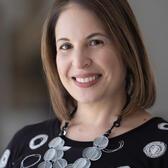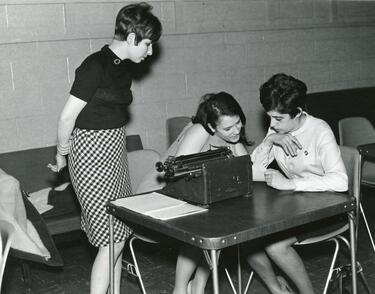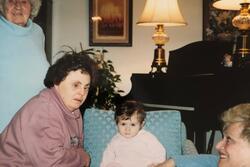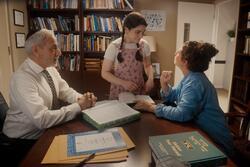One Community’s Journey to Inclusion
As Sharon Alterman sat in the flower shop, carefully arranging her flowers, she noticed people glancing at the group of people she was with. To most onlookers, it probably looked like any class: over a dozen people laughing, chatting, and admiring each other’s work. And it was like any other workshop one might attend, its only difference making the day even more special for Sharon: half the participants were people with developmental disabilities.
For the past three years, JARC’s “Hobbies and Hangouts” program has been a hit, bringing together those they serve with other community members to form friendships and have fun together in a variety of classes. And it’s just one of many ways the people served by JARC have integrated into the larger community. Go to any program in Detroit's Jewish community, and undoubtedly you will see one or more JARC buses in the parking lot, its residents a welcome part of this tight-knit community.
But that wasn’t always the case, as Sharon would be the first to tell you. The battle for the inclusion of the developmentally disabled and their loved ones has been hard-fought. Long before Detroit’s JARC formed to serve this population through group homes, independent living support, and in-home care, it was a very different landscape. And Sharon has seen it all. Over the past 60 years, she has not only had a front-row seat to the changes, she has also spearheaded many of them.
As we celebrate Jewish Disability Awareness, Acceptance, and Inclusion Month this February, let’s take a look back through Sharon’s eyes and appreciate how far we’ve come.
Sharon’s story began in the mid-1960s at the JCC in Detroit. As its newest employee, she was given what was considered by some staff the least desirable task: working with the Thursday Night Social Group (TNSG). Little did Sharon know at the time that it would turn into one of the greatest joys of her life, both professionally and personally.
Starting just five years earlier, the TNSG was a social club for people with developmental disabilities ages 16 and up. The evenings included dancing, sports, swimming, and other activities one might expect from any JCC club. Except, if you asked members of the JCC about this particular club, most wouldn’t have even known it existed; it was a policy at this JCC that the TNSG and other members could not interact.
When a group advocating for the developmentally disabled, co-founded by the formidable Sara Mitteldorf, whose own daughter was disabled, first brought the idea of the TNSG to the JCC, it was met with resistance. The concern was that so-called “normal” members would be offended and withdraw their membership.
Their solution was to separate the TNSG from all other groups. If the group wanted to use the swimming pool, for instance, it would have to be closed and the locker rooms cleared of members. Only once the members of TNSG were gone would the facilities reopen, the public never the wiser.
Within a few years, though, the group slowly began to come out of the shadows and into the public. Thursday nights expanded into trips to nearby Camp Tamarack and then even farther, to Chicago, New York, Washington, DC, and more. Many of the participants had never flown on an airplane or been away from their families overnight. Traveling with the group, Sharon watched as they thrived when given an opportunity for independence and excitement.
Although most of the TNSG members lived with their families, some were bused from local institutions. It was common then for those with disabilities to be placed in institutions as children and remain there for life. There, they would have little to no schooling, minimal activities, and few opportunities to lead a productive, meaningful life. The 1960s, however, was a significant decade for deinstitutionalization.
On the one hand, this was welcome news to those, like Sharon, who had visited an institution and seen what it was like. To this day, she recalls the lack of stimulation, opportunity, and individuality given to the residents. It was a half-lived life, if even that. (For a glimpse of the startling contrast between two developmentally disabled adults, one living in a family home and the other an institution, I recommend the documentary film “Barbara and Yetta.”).
But the other side of the story was one of immense fear. While the TNSG parents understood the limitations of institutions, they also saw them as a safety net. Without institutions, what would happen to their children when they were gone?
Over the four years Sharon had worked with the TNSG, she’d come to know and understand the families' concerns. She’d also been inspired by personal experience. Her cousin and the son of a family friend, both disabled, had been placed in institutions outside of the Jewish community. The feeling that these two people and so many others were being hidden deeply bothered Sharon. So, when the Parents’ Association for Jewish Residential Care (what eventually became JARC) was founded, she was the natural liaison between the organization and the JCC.
As a liaison, Sharon worked alongside the parents to develop a model for group living. It had to be more than merely a safe place to live. It would be a place where housemates became like family, where each person got to express their individuality, and where their Judaism was celebrated— a place where they were not confined to the house, but took part in community activities and could find meaningful jobs, if desired, with the help of Jewish Vocational Service.
That vision was met with an uphill battle, pitting naysayers against determined parents. But in 1972, the first JARC home opened. This was a victory, but the battle wasn't over. Residents fought against group homes in their neighborhoods and tried to relegate them to rural areas. When legislation passed in 1977 in Michigan allowing group homes with six or fewer people to open in any neighborhood without a permit, it was a game changer. Sadly, some neighborhoods still protested proposed group homes, and one JARC home was firebombed. (Luckily, it was empty at the time.) It was a gorgeous home, Sharon lamented, one any person would want to live in.
After eleven years, Sharon left the JCC, but remained dedicated to JARC. She joined the board and became its president one year later. It was during her tenure that JARC hired Joyce Keller, a powerhouse who would serve as executive director for the next 30 years. Under Joyce’s leadership, public awareness grew, opening more doors for those with developmental disabilities. Many more JARC homes opened in Metro Detroit, opportunities for residents increased, and community bonds were strengthened. One of its most powerful programs connects seventh graders from Hillel Day School with JARC participants and is now in its forty-first year.
Today, JARC serves 45 locations and is led by another dynamic woman, Shaindle Braunstein. The deep sense of community that JARC has created within the residences is outmatched only by the love and support given by the greater Detroit Jewish community—a feat even Sharon could not have even imagined when she began working with the Thursday Night Social Group all those years ago.
Sharon, now 83 years old, is the longest-serving JARC board member and the only who has been with the organization since its founding. But she is not alone in having witnessed the momentous changes that have taken place in the developmentally disabled community. Remember Sara Mitteldorf, a driving force in starting the TNSG? While she passed away in 2018, her daughter still lives in a JARC home—just as she has for the past 46 years.







